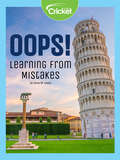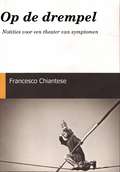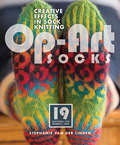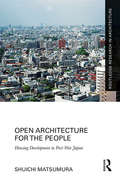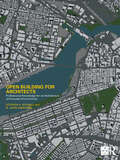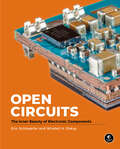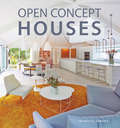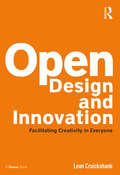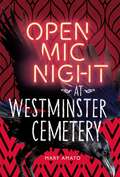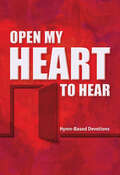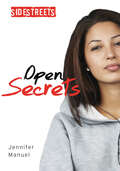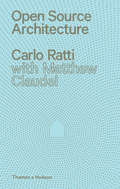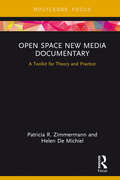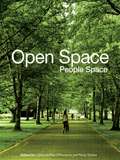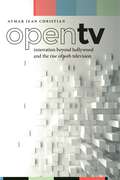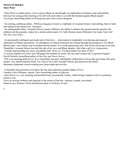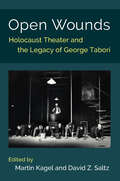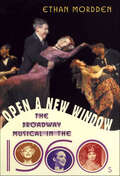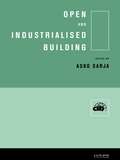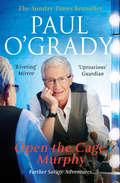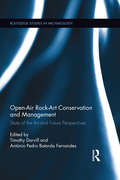- Table View
- List View
Oops! Learning from Mistakes
by Anna M. LewisFor engineers and architects, mistakes are part of the creative process. Learn why the Leaning Tower of Pisa leans, how the reflections from the Walt Disney Concert Hall caused a heat ray, and what engineers and architects did to solve these types of problems.
Op de drempel
by Jannie Meijer Francesco ChianteseEen kort essay over theater van Francesco Chiantese met enkele notities over zijn eerste twintig jaar van theateronderzoek. In limine - Notities voor een theater van symptomen is een verzameling korte notities, bespiegelingen en vragen die Francesco Chiantese zichzelf heeft gesteld in de eerste twintig jaar van zijn leven met theater. Centraal in dit essay staat een gesprek met een van zijn leerlingen. De foto op het omslag is van Daniela Neri www.danielaneri.eu Kan theateronderzoek een nieuw "volkstheater" opleveren? Wat is het "bijgeloof van het begrip"? In welke relatie staat het onderzoek tot de theatertraditie? Kunnen we spreken van een "theater van symptomen"? Francesco Chiantese, theateronderzoeker en een van de velen die de "verborgen scene" van het Italiaanse theateronderzoek begeesteren, stelt deze vragen centraal in zijn bespiegelingen over theater. In limine is een kort essay waarin meer vragen, twijfels en vraagtekens aan bod komen dan antwoorden worden gegeven. Dit essay is geschreven als een flessenpost, in de hoop dat iemand het toevallig vindt en een dialoog wil starten. Genre: UITVOERENDE KUNSTEN / Theater / Algemeen
Op-Art Socks: Creative Effects in Sock Knitting
by Stephanie van der LindenEnjoy a fresh new approach to sock knitting! Stephanie van der Linden is a master knitter and shows her technical skills to great effect in Op-Art Socks. A collector of op-art ceramics, she was inspired to translate graphic optical illusions into knitted patterns for socks, replicating their eye-popping effects. Op-Art Socks contains 19 projects. Explore graphic colorwork, textured knitting (knit and purl), shadow knitting, and shifting ribbing to create optical illusions. The book includes black and white swatches of all patterns so that you can readily perceive the op-art illusions in each piece. Op-Art Socks is truly unique in theme and designs. Go beyond ordinary sock knitting into new territory!
Open Architecture for the People: Housing Development in Post-War Japan (Routledge Research in Architecture)
by Shuichi MatsumuraOpen Architecture for the People explores Japanese architecture and the three different phases of development between the years 1950 and 2018. Changing ways of life through differing generations have caused fluctuations in the building industry. This book demonstrates how each generation's expectations have resulted in discernible eras in architecture which can be examined collectively as well as in isolation. For example, the sudden increase in productivity from 1950 brought about by the Industrial Revolution flowed to the production of buildings and homes and designs were influenced by modern ideas. With over thirty black and white images to illustrate the changes, Matsumura brings to light architectural developments that have previously been confined to Japanese speaking academics. In doing so, the book broadens the scope for further architectural examinations internationally. It would be ideal for academics, students and professionals within the areas of architecture and urban planning, particularly those with an interest in Japanese architecture.
Open Building for Architects: Professional Knowledge for an Architecture of Everyday Environment (Open Building)
by N. John Habraken Stephen H. KendallOpen Building is an internationally recognized approach to the design of buildings and building complexes with roots in the way the ordinary built environment grows and regenerates. The Open Building approach recognizes that both stability and change are realities to be managed in the contemporary built environment. Buildings – and the neighborhoods they occupy – are not static during the most stable times or during times of rapid social and technical change. They are living organisms that need constant adjustments to remain attractive, safe and valuable. Using case studies of built projects from around the world, this book explains the Open Building approach and discusses important characteristics of everyday built environment that the Open Building approach designs for. It also presents a key method that can be used to put the approach into use. It addresses questions such as: • How can we design large projects for inevitable change? • How can we balance the demands of large projects for efficient implementation with the need for ‘fine-grained’ decision-making control? • How can we separate design tasks, one task being the design of what should last a century, the other task being the design of more mutable units of occupancy? • How can we identify and share architectural themes and, at the same time, make variations on them? • How can we use the Open Building approach to steward the earth’s scarce resources and contribute to a circular economy that benefits all people? This book is an essential resource for practitioners, investors and developers, regulators, builders, product manufacturers and educators interested in why the Open Building approach matters and how to practice Open Building.
Open Building for Architects: Professional Knowledge for an Architecture of Everyday Environment (Open Building)
by N. John Habraken Stephen H. KendallOpen Building is an internationally recognized approach to the design of buildings and building complexes with roots in the way the ordinary built environment grows and regenerates. The Open Building approach recognizes that both stability and change are realities to be managed in the contemporary built environment. Buildings – and the neighborhoods they occupy – are not static during the most stable times or during times of rapid social and technical change. They are living organisms that need constant adjustments to remain attractive, safe and valuable.Using case studies of built projects from around the world, this book explains the Open Building approach and discusses important characteristics of everyday built environment that the Open Building approach designs for. It also presents a key method that can be used to put the approach into use. It addresses questions such as: How can we design large projects for inevitable change? How can we balance the demands of large projects for efficient implementation with the need for ‘fine-grained’ decision-making control? How can we separate design tasks, one task being the design of what should last a century, the other task being the design of more mutable units of occupancy? How can we identify and share architectural themes and, at the same time, make variations on them? How can we use the Open Building approach to steward the earth’s scarce resources and contribute to a circular economy that benefits all people? This book is an essential resource for practitioners, investors and developers, regulators, builders, product manufacturers and educators interested in why the Open Building approach matters and how to practice Open Building.
Open Circuits: The Inner Beauty of Electronic Components
by Windell Oskay Eric SchlaepferOpen Circuits is a photographic exploration of the beautiful design inside everyday electronics. Its stunning cross-section photography unlocks a hidden world full of elegance, subtle complexity, and wonder.Our phones, computers, and appliances are made of hundreds of internal components, each precisely engineered to perform a certain function, but none intended to actually be seen. Through painstakingly executed, vividly detailed cross-section photography, Open Circuits reveals the surprising—and often accidental—beauty hiding inside the electronic components that drive our everyday devices. From resistors to LEDs, USB cables to headphone jacks, stepper motors to nixie tubes, the book&’s arresting imagery transforms more than 130 components into delightful works of art. As you visually dissect the components&’ insides, you&’ll learn about how they work and how they were made. Open Circuits has something for everyone to appreciate, whether you&’re a seasoned electrical engineer, an amateur tinkerer, or simply a lover of art and photography.
Open Concept Houses
by Francesc ZamoraFrom the author of the successful 150 Best series comes the debut entry in the forward-thinking Open Concept Houses series, filled with nearly 500 pages of color photos—sure to become the ultimate resource for this fast-growing trend in home design and renovation.One of the hottest lifestyle trends today, open concept living spaces eliminate doorways and walls to create a large combined area for cooking, dining, entertaining, and relaxing. No longer are the kitchen, dining room, and living room compartmentalized. Instead, each space blends into the next to create one large area "separated" and defined by islands, carpets, and furniture. This increasingly popular style provides a sense of expansiveness, connectedness, and flow that traditional architecture and design—defined by spaces broken by walls—lack.This engaging, inspiring, and informative volume brings together a diverse collection of houses from all over the world, including spaces that have been designed from the ground up or have been renovated to reflect this popular trend. Inside Open Concept Houses you’ll find an array of beautiful and creative homes by distinguished international architects and designers who have conceived practical and functional solutions adapted to the specific needs and particular tastes of their clients.Filled with hundreds of full-color photographs as well as sets of floorplans for renovated residences—both the original and remodeled blueprints—this imaginative, idea-filled book is a must-have for architects, designers, decorators, and home owners looking to create or adapt the open concept style in their own dwellings.
Open Design and Innovation: Facilitating Creativity in Everyone
by Leon CruickshankOpen innovation, crowd sourcing, democratised innovation, vernacular design and brand fanaticism are amongst a handful of new approaches to design and innovation that have generated discussion and media coverage in recent years. In practice, these ideas are often inspiring propositions rather than providing pragmatic strategies. Open Design and Innovation develops the argument for a more nuanced acknowledgement and facilitation of 'non-professional' forms of creativity; drawing on lessons from commercial design practice; theoretical analysis and a wider understanding of innovation. Specifically this book examines: innovation and design, the reality and myth of mass creativity and the future of the design profession, through a series of case studies of new approaches to open design practices. The text draws on academic research, practical experience of the author in delivering open design projects and first hand interviews with leaders in the fields. The author challenges the notion of the designer as 'fountain-head' of innovation and, equally, the idea of 'user creativity' as a replacement for traditional design and innovation. The book offers a critique of the hype surrounding some of the emerging phenomena and a framework to help understand the emerging relationship between citizens and designers. It goes on to propose a roadmap for the development of the design profession, welcoming and facilitating new modes of design activity where designers facilitate creative collaborations.
Open House: A Life in 32 Moves
by Jane ChristmasMoving house has never flustered author Jane Christmas. She loves houses: viewing them, negotiating their price, dreaming up interior plans, hiring tradespeople to do the work and overseeing renovations. She loves houses so much that she’s moved thirty-two times.There are good reasons for her latest house move, but after viewing sixty homes, Jane and her husband succumb to the emotional fatigue of an overheated English housing market and buy a wreck in the town of Bristol that is overpriced, will require more money to renovate than they have and that neither of them particularly like.As Jane’s nightmare renovation begins, her mind returns to the Canadian homes where she grew up with parents who moved and renovated constantly around the Toronto area. Suddenly, the protective seal is blown off Jane’s memory of a strict and peripatetic childhood and its ancillary damage—lost friends, divorces, suicide attempts—and the past threatens to shake the foundations of her marriage. This latest renovation dredges a deeper current of memory, causing Jane to question whether in renovating a house she is in fact attempting to renovate her past.With humour and irreverence, Open House reveals that what we think we gain by constantly moving house actually obscures the precious and vital parts of our lives that we leave behind. This is a memoir that will appeal to anyone whose pulse quickens at the mere mention of real estate.
Open Letters
by Alison RowleyDuring the fin-de-siècle and early revolutionary eras, picture postcards were an important medium of communication for Russians of all backgrounds. In Open Letters, the most comprehensive study of Russian picture postcards to date, Alison Rowley uses this medium to explore a variety of aspects of Russian popular culture. The book is lavishly illustrated with more than 130 images, most of which have never been published before.Through her examinations of postcards, Rowley addresses a diverse range of topics: how landscape postcards conveyed notions of imperialism; the role of postcards in the rise of celebrity culture; depictions of the body on erotic and pornographic postcards; how postcards were employed to promote differing interpretations of the First World War; and the use of postcards by revolutionary groups seeking to overthrow the Tsarist government. Rowley determines the extent to which Russia was embedded in Europe-wide cultural trends by situating the Russian case within a larger European context.
Open Mic Night at Westminster Cemetery
by Mary AmatoWhen Lacy wakes up dead in Westminster Cemetery, final resting place of Edgar Allan Poe, she's confused. It's the job of Sam, a young soldier who died in 1865, to teach her the rules of the afterlife and to warn her about Suppression—a punishment worse than death. Lacy desperately wants to leave the cemetery and find out how she died, but every soul is obligated to perform a job. Given the task of providing entertainment, Lacy proposes an open mic, which becomes a chance for the cemetery's residents to express themselves. But Lacy is in for another shock when surprising and long-buried truths begin to emerge.
Open My Heart to Hear: Hymn-Based Devotions
by Northwestern Publishing HouseDive deeper into the beauty of time-treasured and new favorite worship songs in this collection of hymn-based devotions!Open My Heart to Hear is an opportunity to meditate on the words of beloved hymns and marvel at how they point you to the amazing nature of God's love for you. From "Savior of the Nations," "Come," and "When I Survey the Wondrous Cross," to "Christ Is with Me" and "Do Not Let Your Hearts Be Troubled," hymns both familiar and new form the foundation for the faith-strengthening truths expressed in these 90 brief devotions based on hymns from Christian Worship: Hymnal. Explore the riches of God's grace in each hymn's poetry in this collection of devotions and pray alongside the hymn writer: "Lord, open now my heart to hear, and through your Word to me draw near"
Open Secrets (Lorimer SideStreets)
by Jennifer ManuelSeventeen-year-old Ana Santos has ambitions to make it big in music. When she signs a contract with the owner of a music café, she has no idea there are sexual strings attached. This book looks at the darker side of the music industry, including sexual harassment, lyrics that degrade and demean women, and social media trolling as backlash for speaking up. Ana is a strong, realistic main character who overcomes her feelings of shame to find a voice for herself and her music. The #MeToo movement has revealed the prevalence of sexual assault in society, and an issue that also affects the lives of teen girls. Distributed in the U.S by Lerner Publishing Group
Open Source Architecture
by Carlo Ratti Matthew ClaudelA provocative look at the architecture of the future and the challenges of learning from the past Open Source Architecture is a visionary manifesto for the architecture of tomorrow that argues for a paradigm shift from architecture as a means of supporting the ego-fueled grand visions of "starchitects" to a collaborative, inclusive, network-driven process inspired by twenty-first-century trends such as crowd-sourcing, open access, and mass customization. The question is how collaborative design can avoid becoming design-by-committee. Authors Carlo Ratti and Matthew Claudel navigate this topic nimbly in chapters such as "Why It Did Not Work" and "Learning from the Network." They also meet the essential requirement of any manifesto, considering the applications of open-source architecture not only conceptually but also in practice, in chapters such as "Open Source Gets Physical" and "Building Harmonies." Open Source Architecture is an important new work on the frontlines of architectural thought and practice.
Open Space New Media Documentary: A Toolkit for Theory and Practice (Routledge Studies in Media Theory and Practice)
by Patricia R. Zimmermann Helen De MichielOpen Space New Media Documentary examines an emerging and significant area of documentary practice in the twenty-first century: community-based new media documentary projects that move across platforms and utilize participatory modalities. The book offers an innovative theorization of these collaborative and collective new media practices, which the authors term "open space," gesturing towards a more contextual critical nexus of technology, form, histories, community, convenings, collaborations, and mobilities. It looks at a variety of low cost, sustainable and scalable documentary projects from across the globe, where new technologies meet places and people in Argentina, Canada, India, Indonesia, Peru, South Africa, Ukraine, and the USA.
Open Space: Open Space: People Space 2
by Catharine Ward Thompson Penny TravlouHighly visual and containing contributions from leading names in landscape, architecture and design, this volume provides a rare insight into people’s engagement with the outdoor environment; looking at the ways in which the design of spaces and places meets people’s needs and desires in the twenty-first century. Embracing issues of social inclusion, recreation, and environmental quality, the editors explore innovative ways to develop an understanding of how the landscape, urban or rural, can contribute to health and quality of life. Open Space: People Space examines the nature and value of people’s access to outdoor environments. Led by Edinburgh’s OPENspace research centre, the debate focuses on current research to support good design for open space and brings expertise from a range of disciplines to look at: an analysis of policy and planning issues and challenges understanding the nature and experience of exclusion the development of evidence-based inclusive design innovative research approaches which focus on people’s access to open space and the implications of that experience. Invaluable to policy makers, researchers, urban designers, landscape architects, planners, managers and students, it is also essential reading for those working in child development, health care and community development.
Open TV: Innovation beyond Hollywood and the Rise of Web Television (Postmillennial Pop #20)
by Aymar Jean ChristianHow the internet transformed television Before HBO’s hit show Insecure, Issa Rae’s comedy about being a nerdy black woman debuted as a YouTube web series The Misadventures of Awkward Black Girl, her response to the absence of diverse black characters on the small screen. Broad City, a feminist sitcom now on Comedy Central, originated as a web series on YouTube, developed directly out of funny women Ilana Glazer and Abbi Jacobson’s real-life friendship. These unconventional stories took advantage of the freedom afforded outside the traditional television system: online. Open TV shows how we have left “the network era” far behind and entered the networked era, with the web opening up new possibilities for independent producers, entrepreneurs, and media audiences. Based on interviews with writers, producers, show-runners, and network executives, visits to festivals and award shows, and the experience of producing his own series, Aymar Jean Christian argues that the web brought innovation to television by opening up series development to new producers, fans, and sponsors that had previously been excluded. Online access to distribution provides creative freedom for indie producers, allows for more diverse storytelling from marginalized communities, and introduces new ways of releasing and awarding shows. Open TV is essential reading for anyone interested in the changing environment of television and how the internet can inspire alternatives to what’s on TV tonight.
Open Water
by Nelson Caleb AzumahTwo young people meet at a pub in South East London. Both are Black British, both won scholarships to private schools where they struggled to belong, both are now artists - he a photographer, she a dancer - trying to make their mark in a city that by turns celebrates and rejects them. Tentatively, tenderly, they fall in love. But two people who seem destined to be together can still be torn apart by fear and violence.
Open Wounds: Holocaust Theater and the Legacy of George Tabori
by David Z. Saltz Martin KagelThis volume collects original essays on Hungarian-German playwright and screenwriter George Tabori (1914–2007) and his remarkable contributions to the stage. Tabori, a Jewish refugee and a truly transnational author, was best known for his work in New York theater that irreverently explored the Jewish experience, particularly the Holocaust. Although his illustrious career spanned a century, two continents, several languages, and a variety of literary genres, Tabori’s work has received scant attention in American letters, in spite of its significance for U.S. theater and Holocaust studies. Until Tabori, most dramas about the Holocaust were either rooted in American domestic realism, striving to create a strong empathetic connection between the audience and Holocaust victims, or featured an unembellished documentary style. Tabori staked out a third position, beyond realism and documentation. The volume brings together the voices of international scholars to provide a comprehensive introduction to Tabori’s theater as well as in-depth analyses of his work, discussing all of his major plays. Individual essays address Tabori’s postdramatic theater in relation to sacrificial ritual, performance studies, and post-humanist approaches to the contemporary stage, as well as performance aspects of his productions, questions of ethics and aesthetics raised by his theater, and his plays’ relation to Holocaust representation in popular culture.
Open Wounds: Holocaust Theater and the Legacy of George Tabori
by David Z. Saltz Martin KagelThis volume collects original essays on Hungarian-German playwright and screenwriter George Tabori (1914–2007) and his remarkable contributions to the stage. Tabori, a Jewish refugee and a truly transnational author, was best known for his work in New York theater that irreverently explored the Jewish experience, particularly the Holocaust. Although his illustrious career spanned a century, two continents, several languages, and a variety of literary genres, Tabori’s work has received scant attention in American letters, in spite of its significance for U.S. theater and Holocaust studies. Until Tabori, most dramas about the Holocaust were either rooted in American domestic realism, striving to create a strong empathetic connection between the audience and Holocaust victims, or featured an unembellished documentary style. Tabori staked out a third position, beyond realism and documentation. The volume brings together the voices of international scholars to provide a comprehensive introduction to Tabori’s theater as well as in-depth analyses of his work, discussing all of his major plays. Individual essays address Tabori’s postdramatic theater in relation to sacrificial ritual, performance studies, and post-humanist approaches to the contemporary stage, as well as performance aspects of his productions, questions of ethics and aesthetics raised by his theater, and his plays’ relation to Holocaust representation in popular culture.
Open a New Window: The Broadway Musical in the 1960s (The History of the Broadway Musical)
by Ethan MorddenIn the 1960s, the Broadway musical was revolutionized from an entertainment characterized by sentimental standards, such as Camelot and Hello, Dolly!, to one of brilliant and bittersweet masterpieces, such as Cabaret and Fiddler on the Roof. In Open a New Window, Ethan Mordden continues his history of the Broadway musical with the decade that bridged the gap between the romantic, fanciful entertainments of the fifties, such as Call Me, Madam, to the seventies when sophisticated fare, such as A Little Night Music and Follies, was commonplace. Here in brilliant detail is the decade and the people that forever transformed the Broadway muscial.
Open and Industrialised Building
by Asko SarjaThere is clearly potential for the industrial production of open buildings, buildings where the parts which are designed to allow a high degree of freedom for layout, construction and adaptation. Industrialized open building has the potential to radically cut building costs and construction time.This book focuses on product and production systematics and information systematics, and begins with an extensive survey of the field by the editor. The second part consists of a series of descriptions of the experience of different countries, and chapters on particular themes. The book presents new material developed from Commission W24 of the CIB (the International Council for Building Research Studies and Documentation).
Open the Cage, Murphy!: Hilarious tales of the rise of Lily Savage
by Paul O'GradyTHE SUNDAY TIMES BESTSELLER'With typical razor-sharp wit and candour, Paul tells of his rise to fame as Lily Savage . . . Riveting.' Daily MirrorFrom Britain's most beloved TV star, Open the Cage, Murphy is an action-packed roller-coaster ride through a decade of Paul O'Grady's life, stuffed full to the gunwales with hilarious stories, extreme situations and outrageous one-liners.A must read for any Paul O'Grady fan, Open the Cage, Murphy follows his brilliant comic creation Lily Savage as she embraces success and world domination beckons.From being involved in a plane crash, to getting caught up in the LA riots and a close encounter with Madonna, the stories come thick and fast. Paul takes us with him to a gay-themed weekend in Butlin's in Skegness, on a rowdy tour with Prisoner Cell Block H - the Musical and into the depths of the Australian rainforest, where he befriends a rare bird that can disembowel a man with a single kick. The dramatis personae include a family of dolphins, Charlton Heston and the ghost of Joan of Arc - and there's a starring role for a certain remarkable dog, Buster Elvis Savage.But whether he's writing about star-studded Hollywood parties, the devastating loss of close friends to AIDS, or late night shenanigans at the end of Blackpool Pier, Paul's wit and humanity never desert him.Open the Cage, Murphy is a genuine delight - all the more so for being delightfully genuine.Readers love Open the Cage, Murphy!'I couldn't put it down . . . Paul comes across as a very intelligent man . . . with a heart of gold under that naughty exterior.' *****'This is such a great read, Paul is excellent when describing things makes you feel as though you are there with him. His humour warmth and caring comes out in abundance.' *****'An excellent read. He takes you through the highs and lows of his life, you laugh and cry with him.' *****
Open-Air Rock-Art Conservation and Management: State of the Art and Future Perspectives (Routledge Studies in Archaeology #12)
by Timothy Darvill António Pedro Batarda FernandesWhile much has been achieved in understanding and managing weather effects and erosion phenomena affecting ancient imagery within the relatively protected environments of caves and rock-shelters, the same cannot be said of rock-art panels situated in the open-air. Despite the fact that the number of known sites has risen dramatically in recent decades there are few examples in which the weathering and erosion dynamics are under investigation with a view to developing proposals to mitigate the impact of natural and cultural processes. Most of the work being done in different parts of the world appears to be ad-hoc, with minimal communication on such matters between teams and with the wider archaeological community. This richly illustrated book evaluates rock-art conservation in an holistic way, bringing together researchers from across the world to share experiences of work in progress or recently completed. The chapters focus on a series of key themes: documentation projects and resource assessments; the identification and impact assessment of weathering/erosion processes at work in open-air rock-art sites; the practicalities of potential or implemented conservation interventions; experimentation and monitoring programs; and general management issues connected with public presentation and the demands of ongoing research investigations. Consideration is given to the conservation of open-air rock-art imagery from many periods and cultural traditions across the Old and New Worlds. This timely volume will be of interest to conservators, managers, and researchers dealing with aesthetic and ethical issues as well as technical and practical matters regarding the conservation of open-air rock-art sites.
